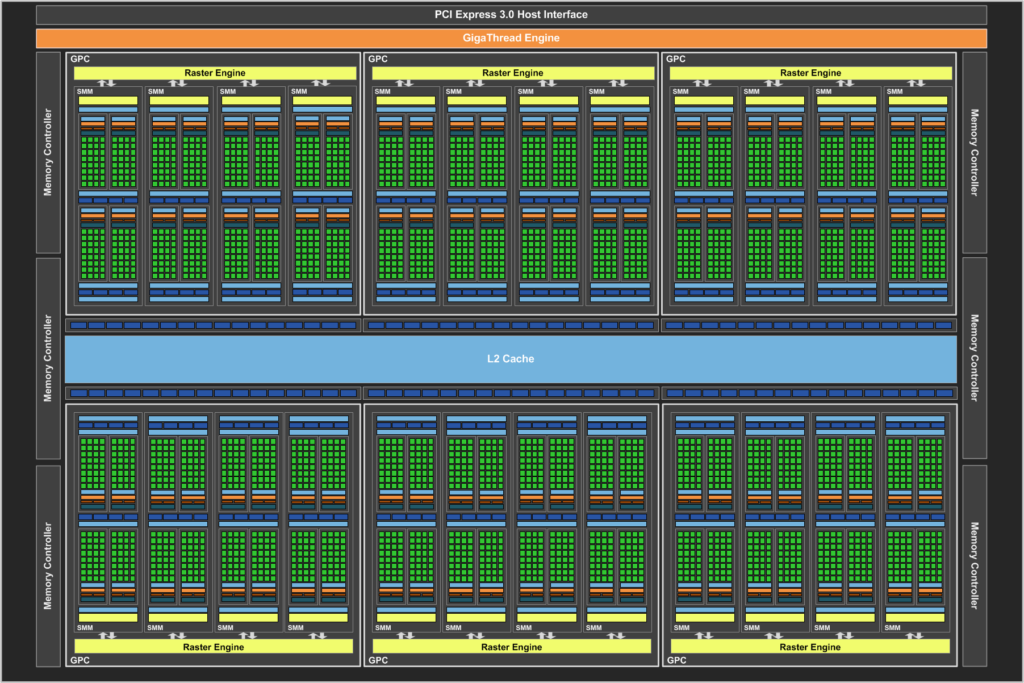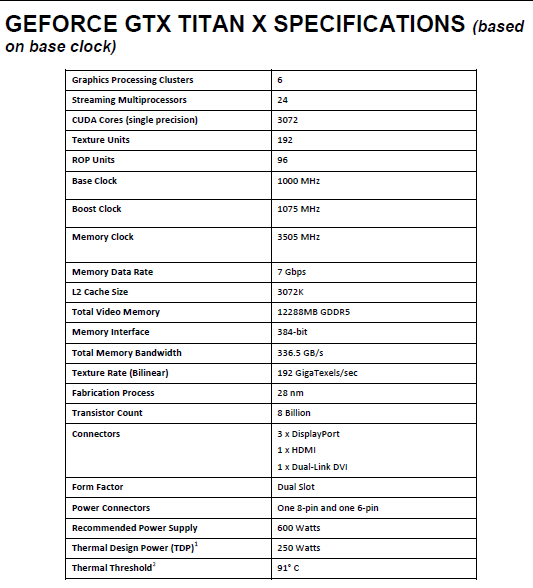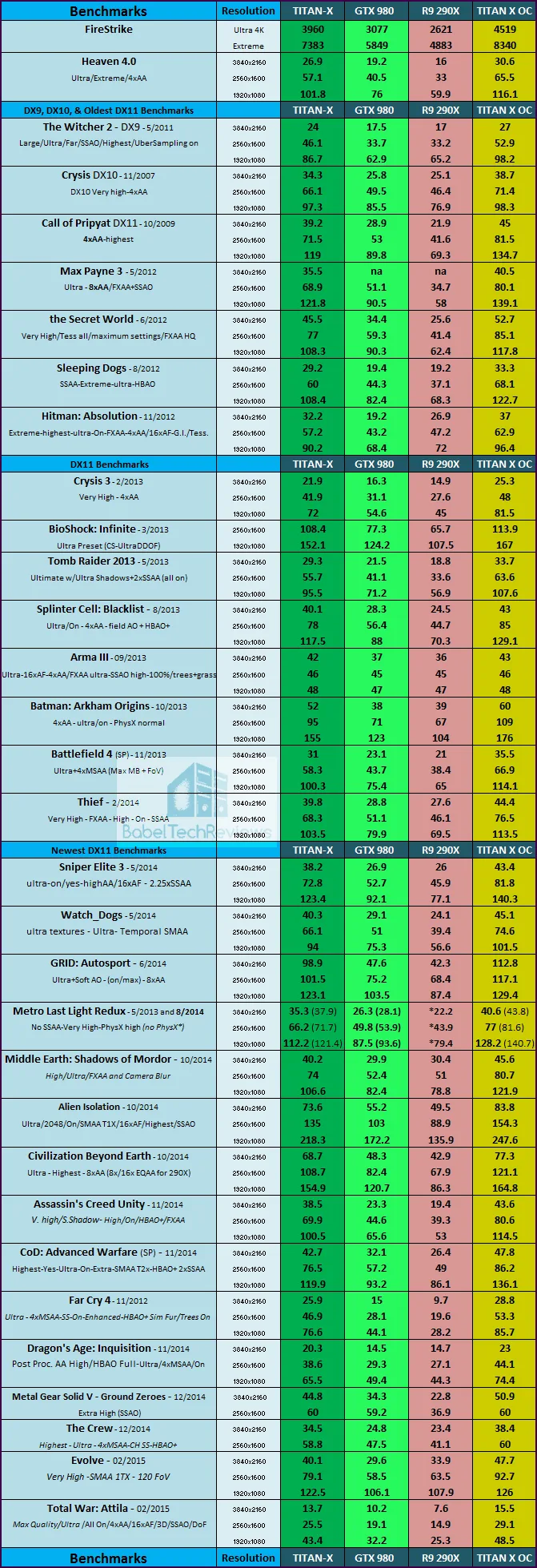BabelTechReviews is at Nvidia’s GPU Technology Conference for the next four days. Nvidia’s CEO Jensen has just fully unveiled and hard launched for sale the new DX12 Level 1, fully-enabled, 8 billion transistor Maxwell flagship GTX TITAN X at $999. With 3072 CUDA cores and 12GB of VRAM, it promises to be significantly faster than the GTX 980, and much faster than AMD’s aging flagship, the R9 290X.
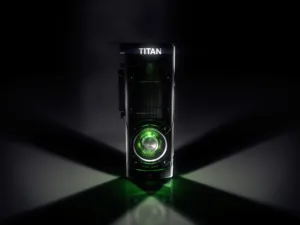 BTR received a TITAN X from Nvidia this last Friday and we have put it through its stock and overclocked paces with our updated 30-game PC benchmark suite against the GTX 980 and the R9 290X.
BTR received a TITAN X from Nvidia this last Friday and we have put it through its stock and overclocked paces with our updated 30-game PC benchmark suite against the GTX 980 and the R9 290X.
We are testing all of our competing cards on a clean installation of Windows 8.1 using resolutions of 1920×1080, 2560×1600 and at 4K’s 3840×2160. As befits testing top video cards, we use Intel’s enthusiast Z97 platform with Core i7 4790K turboed to 4.4GHz, and 16GB of Kingston’s 2133MHz Predator DDR3.
Before we give you the results of our performance testing, we want to briefly recap Maxwell architecture, as well as detail the specifications and features of the new GTX TITAN X.
Key Features of the Maxwell GTX TITAN X
The GTX 980 and the GTX 970 both launched last September as Maxwell GM204 architecture , and both of them are faster than AMD’s flagship, the R9 290X. The GTX 960 is a smaller chip also based on the Maxwell GM206 architecture and it was released in January at the 200 dollar price point. The GeForce GTX 980, 970 and GTX 960 GPUs support all-new graphics features formerly available only to them, and are now available on the GM220 GTX TITAN X. Nvidia’s Voxel Global Illumination (VXGI) technology allows the new GPUs to render fully dynamic global illumination at playable frame rates bringing more realism and immersion to gamers. Although it is not real-time ray tracing, it a good step in that direction.
PC games can also perform and look better with new anti-aliasing modes like Multi-Frame sampled AA (MFAA) which works particularly well with 4K resolution. MFAA combines multiple AA sample positions to produce a result that looks like higher quality anti-aliasing, but with better performance. From our testing of MFAA, it appears to produce an image that looks very similar to 4xMSAA at the performance cost of roughly 2xMSAA. Until the TITAN X launch now, MFAA was only available to the GTX 980, the GTX 970 and the GTX 960.
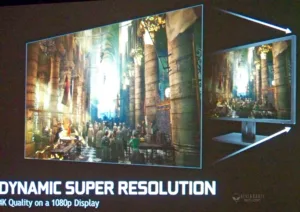 The new GeForce Maxwell GPUs also support Dynamic Super Resolution (DSR) which is similar to driver-based SuperSampling. DSR brings the crisp detail of 4K resolution to 1920×1080 displays. It looks great, but without a FCAT capture, screen shots cannot be shown with Fraps. These Maxwell GPUs retain and improve on features like ShadowPlay, which now support recording at resolutions up to 4K at 60 fps. And with the new G-SYNC displays, gamers no longer have to put up with tearing or stutter as part of the current common gaming experience.
The new GeForce Maxwell GPUs also support Dynamic Super Resolution (DSR) which is similar to driver-based SuperSampling. DSR brings the crisp detail of 4K resolution to 1920×1080 displays. It looks great, but without a FCAT capture, screen shots cannot be shown with Fraps. These Maxwell GPUs retain and improve on features like ShadowPlay, which now support recording at resolutions up to 4K at 60 fps. And with the new G-SYNC displays, gamers no longer have to put up with tearing or stutter as part of the current common gaming experience.
The next generation of games will not only look better and run faster on the GeForce GTX 9X0s and on the TITAN X, they’ll also be more immersive thanks to virtual reality headsets like the Oculus Rift. With VR Direct, Nvidia has developed a number of advancements for virtual reality reducing latency, improving image quality, and bringing a whole range of new content to VR.
This editor has already experienced an Oculus Rift demo created from Unreal Engine 4’s Infiltrator assets at Nvidia’s 2014 Maxwell Press Event that is an awesome extension of S3D. VR frame rates need to be locked to a minimum of 75 fps for fluidity – and they need to be rendered twice, once for each eye. Eventually, as the resolution increases, the grainy look will disappear allowing for more realism, but at the price of requiring extreme graphics performance from the video card or cards like the TITAN X. We expect to check out the new VR demos at the GTC and we will report on them in our GTC wrap-up article.
The Maxwell GM204 GTX 980 versus the GM220 GTX TITAN X
First, take a look at the GM204 block diagram which represents the GTX 980 – and until today’s TITAN X launch – the world’s fastest GPU: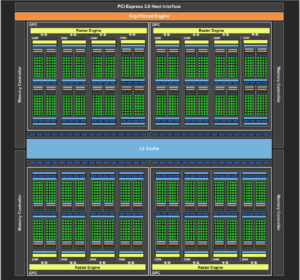
The GTX 980 GM204 has 64 Raster Operating Units, double Kepler GK110’s 32.
There are 5.2 billion transistors packed into the GM204’s die size of 398 mm2.
The GTX 980 has only a TDP of 165W and the GeForce GTX 9x0s have HDMI 2.0 support and support for 4 displays
Now check out the differences by looking at the GM220 block diagram of the fully enabled 8-billion transistor Maxwell GM220 with 24 SMX units and 3072 CUDA cores:
There is quite a difference between the TITAN X and the GTX 980 besides the size of the GPUs. The base clock of the GTX TITAN X is 1000MHz with a typical boost clock of at least 1075MHz. The TITAN X texture filtering is performed by 192 texture units leading to 192 gigatexels/second, or more than one third faster than the GTX 980. And GM200’s memory subsystem is also much more robust in the TITAN X by giving 335GB/second, or more than 50% more peak memory bandwidth over the GTX 980 by using a 384-bit memory interface (six 64-bit memory controllers) with 7GHz memory clocks.
Here is the SM diagram for the GM220: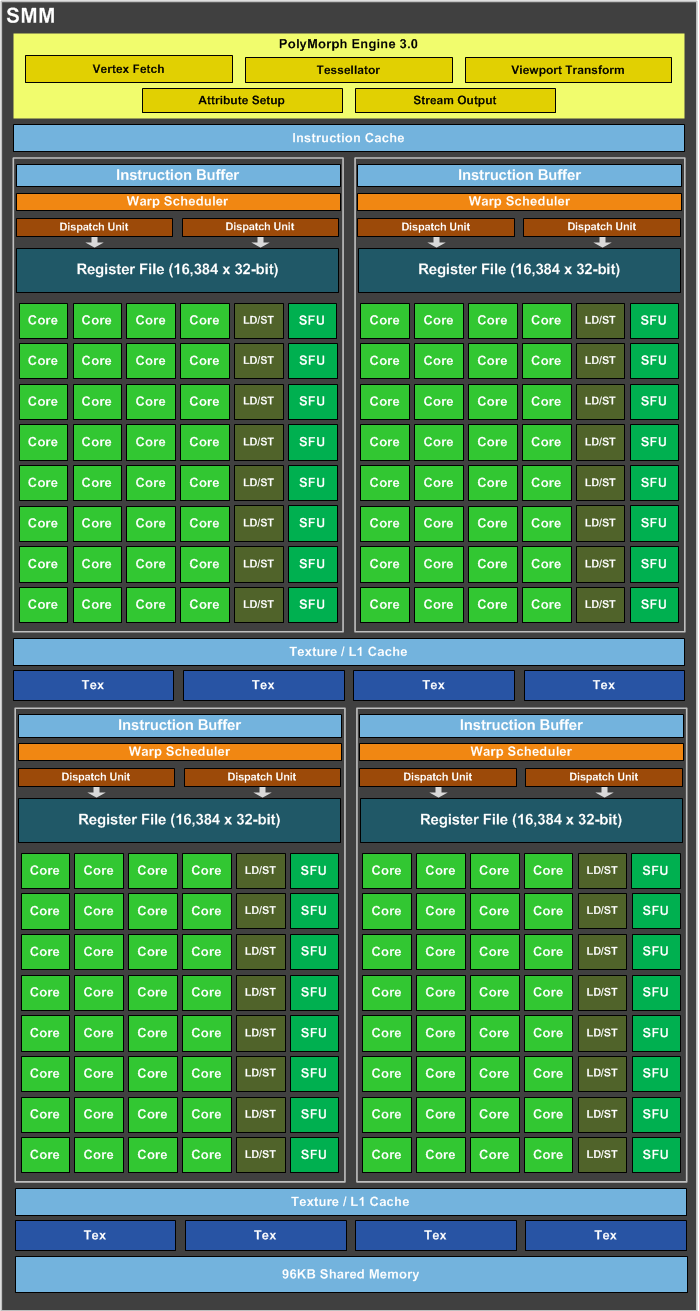
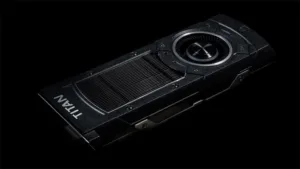 One key difference is the 12GB of vRAM used in the GTX TITAN X, compared with 4GB used in the GTX 980. This means that the TITAN X will not run out of video memory at 4K even with multiple displays. And we found at least one game that will simply not run at the extreme settings on the GTX 980 at 4K, but will run fine on the GTX TITAN X.
One key difference is the 12GB of vRAM used in the GTX TITAN X, compared with 4GB used in the GTX 980. This means that the TITAN X will not run out of video memory at 4K even with multiple displays. And we found at least one game that will simply not run at the extreme settings on the GTX 980 at 4K, but will run fine on the GTX TITAN X.
The display/video engines are unchanged in TITAN X from the GTX 980 and the overall double precision instruction throughput is 1/32 the rate of single precision throughput in both GPUs. The GTX TITAN X is primarily built for extreme GeForce gaming and is by no means a budget card. Price conscious video gamers will most likely choose a pair of GTX 970s instead. For the extreme enthusiast, no doubt two, three, or four GTX TITAN X video cards may be used together in SLI to power multiple 4K displays, something the SLI’d GM204 GPUs cannot handle.
The GTX TITAN is a regular-sized 10.5″ video card with a TDP of 250W using one 6-pin and one 8-pin PCIe connectors. Display outputs include one Dual Link DVI, one HDMI 2.0 connector for use with the latest HDTVs, and three DisplayPort connectors. There is no backplate on the TITAN X as there is with the GTX 980 because the TITAN X is a much warmer-running card, and even a removable black plate cover is impractical on the reference design because of the screw length.
The TITAN X continues the tradition of Nvidia’s original TITAN Industrial Designer look, but in black matte painted aluminum. It uses a copper vapor chamber combined with a large aluminum dual heatsink to dissipate the GM200’s heat. Unlike its competitor, AMD’s R9 290X, the TITAN X is very quiet, reaching only about 3300 rpm under full load and topping out with a peak temperature of 87C under the very hot Summer-like conditions of our testing lab.
Southern California has been having a heatwave with record temperatures over the past weekend, and we have had to run our 290X late at night to prevent its throttling. We found no such throttling issues with the TITAN X, even when ambient temperatures surpassed 80F in our testing lab!
Specifications
Here are the specifications for the GM204 GTX 980:
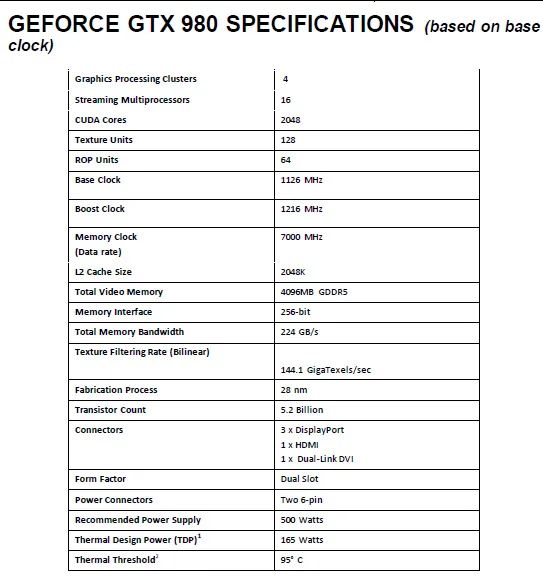 Now let’s look at the TITAN X:
Now let’s look at the TITAN X:
There were quite a few changes between the GTX 980 and the GTX TITAN X. Everything that applies to GM204 also applies to GM220 and it may be worth checking out our September GTX 980/970 launch article.
How does the GTX TITAN X compare with its rival, AMD’s R9 290X?
It doesn’t. Although the GTX 980 is mostly faster than the 290X, TITAN X is simply in a class above the 290X and even over the GTX 980. How far? By just looking at the specification, it looks like the GTX TITAN X will be about 30 to 50% faster than the GTX 980 and also significantly faster than the 290X. We are going to look at the performance of 30 games to compare the TITAN X with the GTX 980 and the R9 290X.
However, before we do performance testing, let’s take a closer look at the GTX TITAN X and check out overclocking and noise.
A look at the TITAN X, Overclocking, and noise
The GTX TITAN X is good-looking card.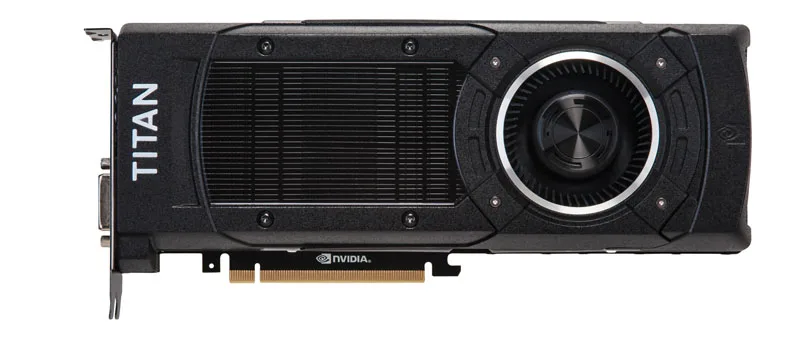
We can see that there is one dual link DVI port, three HDMI 2.0 ports. and a DisplayPort in this view of the stripped down TITAN X board.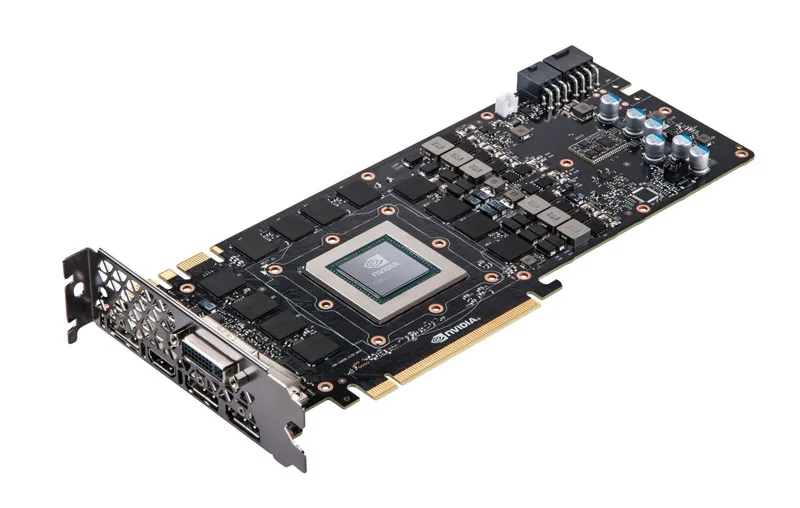
Here you can see the GTX TITAN X with its blower fan. This series of professional pictures is by Nvidia. We simply didn’t have time for our own pictures, concentrating on performance testing over 3 days instead.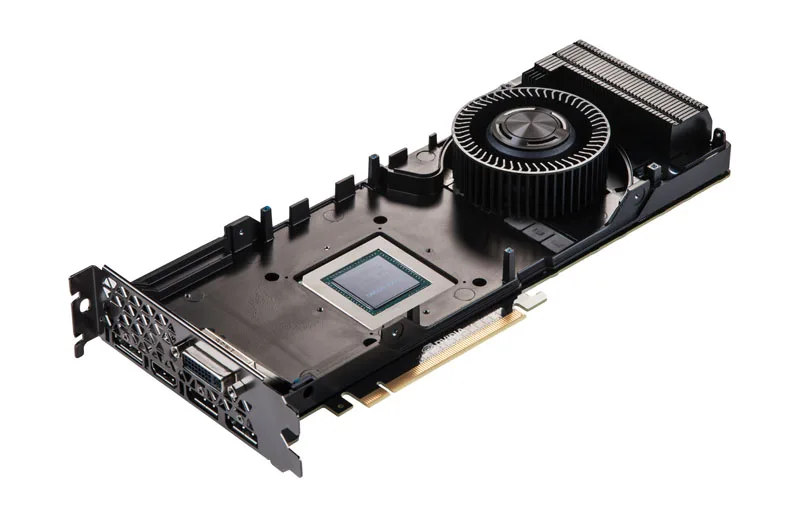 And here is the aluminium cooler:
And here is the aluminium cooler:
And here is the GTX TITAN with a view of the PCIe connectors which are set up for SLI, as well as for Tri- and for Quad-SLI. There is a 6-pin plus an 8-pin power connector which is useful for overclocking.  Here is a straight look at the edge. The GeForce logo lights up and can even be set up to provide a light show to match your mood or the music.
Here is a straight look at the edge. The GeForce logo lights up and can even be set up to provide a light show to match your mood or the music. The other side is just a raw PCB. The GTX 980s backplate looks much nicer than the raw PCB of the TITAN X, but evidently it was impractical to design one for the GTX TITAN X.
The other side is just a raw PCB. The GTX 980s backplate looks much nicer than the raw PCB of the TITAN X, but evidently it was impractical to design one for the GTX TITAN X.
The chip itself is quite large but Nvidia didn’t share a photo of it..
SLI and Tri-SLI
The GTX TITAN X is set up for SLI as well as for Tri- and Quad-SLI. We hope to cover SLI performance of the GTX 980 as well as CrossFired 290Xes versus a single GTX TITAN X in an upcoming article.
The specifications look extraordinary with solid improvements over the GM204 GTX 980. Let’s check out performance after we look at our test configuration on the next page.
Test Configuration – Hardware
Test Configuration – Hardware
- Intel Core i7-4790K (reference 4.0GHz, HyperThreading and Turbo boost is on to 4.4GHz; DX11 CPU graphics), supplied by Intel.
- ASUS Z97-E motherboard (Intel Z97 chipset, latest BIOS, PCOe 3.0 specification, CrossFire/SLI 8x+8x)
- Kingston 16 GB HyperX Beast DDR3 RAM (2×8 GB, dual-channel at 2133MHz, supplied by Kingston)
- GeForce GTX 980, 4GB reference clocks, supplied by Nvidia
- GeForce GTX TITAN X, 12GB, reference clocks and further overclocked, supplied by Nvidia
- PowerColor R9 290X PCS+, 3GB, reference design at reference clocks.
- Two identical 2TB Toshiba 7200 rpm HDDs; the only differences are the VGA drivers, one AMD HDD and one HDD for Nvidia
- EVGA 1000W power supply unit
- Cooler Master Seidon watercooler, supplied by Cooler Master
- Onboard Realtek Audio
- Genius SP-D150 speakers, supplied by Genius
- Thermaltake Overseer RX-I full tower case, supplied by Thermaltake
- ASUS 12X Blu-ray writer
- HP LP3065 2560×1600 30″ LCD display
- Monoprice Crystal Pro K display.
- Test Configuration – Software
-
- Nvidia GeForce 347.52 WHQL drivers for the GTX 980; GeForce 347.84 launch drivers for the GTX TITAN X. High Quality, prefer maximum performance, single display.
Windows 8.1 64-bit; very latest updates. All DX 9 titles were run under the DX9 render path, DX10 titles were run under DX10 render paths; DX11 titles under DX11 render paths.
Latest DirectX
All games are patched to their latest versions.
VSync is off in the control panel.
AA enabled as noted in games; all in-game settings are specified with 16xAF always applied; 16xAF forced in control panel for Crysis.
All results show average frame rates unless noted.
Highest quality sound (stereo) used in all games.
The 33 Game benchmarks & 3 synthetic tests
- Synthetic
- Nvidia GeForce 347.52 WHQL drivers for the GTX 980; GeForce 347.84 launch drivers for the GTX TITAN X. High Quality, prefer maximum performance, single display.
- Firestrike – Basic & Extreme
- Heaven 4.0
- The Witcher 2
- Crysis
- STALKER, Call of Pripyat
- Max Payne 3
- the Secret World
- Sleeping Dogs
- Hitman: Absolution
- Far Cry 3
- Tomb Raider: 2013
- Crysis 3
- BioShock: Infinite
- Metro: Last Light Redux (2014)
- Battlefield 4
- Splinter Cell: Blacklist
- ArmA 3
- Total War: Rome II
- Batman: Arkham Origins
- Thief
- Sniper Elite 3
- Watch_Dogs
- GRID: Autosport
- Middle Earth: Shadows of Mordor
- Alien Isolation
- Assassin’s Creed Unity
- Civilization Beyond Earth
- Call of Duty: Advanced Warfare
- Far Cry 4
- Dragon’s Age: Inquisition
- Metal Gear Solid V: Ground Zeroes
- The Crew
- Evolve
- Total War: Attila
Before we get to the GTX TITAN X performance charts, let’s look at overclocking, power draw and temperatures.
Overclocking, Power Draw & Temperatures
Overclocking the GTX TITAN X is just as easy as overclocking Kepler with the same features. We did notice that adding voltage acted to stabilize our GTX 980 more than it acted with Kepler GPUs, and the same appears to be true of the TITAN X. We were able to overclock further, adding +200MHz offset to the core with nearly complete stability in over 30 games, even though we did not adjust the voltage nor our fan profile. Only a couple of games required us to either add voltage or drop the overclock one notch to +185MHz offset.
We finally settled on a +200MHz offset to the core clocks and +200MHz offset on the memory clocks with very good stability although we were not able to add another +10MHz to the memory clocks without some artifacting.
Using maxed-out Heaven 4.0 looped in a window at 2560×1440, with all settings at stock values (Power and temperature targets are always maxed out), the Peak Boost that we observed was 1151MHz to 1164MHz. Even with temperatures in our testing room more than a very hot 80F, temperatures never reached over 87C under full load, and the fan was just somewhat noticeable at 3300 rpm under full overclocked load. Voltage ranged from 1.13V to 1.143V over a full range of higher clocks.
Adding +200MHz to the core brought the peak base clock up to 1201MHz and it stabilized there when the temperature exceeded 80C. Our stock boost clock reached 1164MHz although it stabilized at 1151MHz. The fan needed to ramp up to a reasonably quiet 3300 rpm to keep the core temps below 86C. Boosting the memory clocks +200MHz brought the temps up a bit more, although the fan needed to ramp where it became more audible although it is not loud nor irritating as it is with the 290X’s noise.
We finally settled on +200MHz offset to the core and +200MHz offset to the memory as stable for our overall benching and games that we tested on a very hot Summer-like California Winter day.
Noise
The GTX TITAN X is reasonably quiet for a high-end flagship card and in stark contrast to the reference version of the R9 290X. The GTX 680 and the reference GTX 770 are already quiet for powerful cards, but the GTX 980 along with the GTX 780/Ti are noticeably quieter although our TITAN X may be slightly noisier under full load. The automatic fan profiles worked well and they needed no tweaking even while benching using our maximum overclock.
It appears that Nvidia has especially tuned the GTX TITAN to be slightly less quiet than their other recent high-end cards, but not at the expense of cooling. It will be interesting to see what cooling designs their partners may implement.
Let’s head to our performance charts.
Performance summary charts & graphs
Here are the summary charts of 30 games and 2 synthetic tests. The highest settings are always chosen and it is DX11 when there is a choice; DX10 is picked above DX9, and the settings are ultra or maxed. Specific settings are listed on the Main Performance chart. The benches were run at 1920×1200, 2560×1600, and at 3840×2160.
All results, except for FireStrike, show average framerates and higher is always better. In-game settings are fully maxed out and they are identically high or ultra across all platforms. We see some very impressive results with the GTX 980 beating the R9 290 that are simply eclipsed by the GTX TITAN X.
In the first column of the main performance summary chart, the GTX TITAN X is tested followed by the GTX 980 and the 290X in the third column. Column four is the new Maxwell GTX TITAN X overclocked +200MHz core/+200MHz.
The Crew and Metal Gear Solid V each have a hard cap on the framerate at 60fps which is why we used maximum setting only at the highest resolutions for the GTX TITAN X.
It is an absolute blowout and the R9 290X is left in the dust by the GTX TITAN X. Even the GTX 980 is significantly slower than the new TITAN X. There are no games out of 30 where the Radeon even manages to tie TITAN X although it does come close to the GTX 980 in a couple of games.
We can see that the overclocked GTX TITAN X scales very well with increasing clockspeeds and no overclocked watercooled 290X will manage to make up the deficit. We can only assume that unless AMD has a strong reply in a successor to the R9 290X, they will have to cut prices one more time.
Let’s head for our conclusion.
Conclusion
This has been quite an enjoyable, if far too short, 3-day exploration for us in evaluating our new GTX TITAN X since Friday of this last week. It did very well performance-wise comparing it to the the GTX 980 where it brings higher performance. We are totally impressed with this high-performance Maxwell GM220 flagship chip that has such outstanding overclockability and a good price considering its ultra performance at 4K. It slots well above the GTX 980 and far, far above the R9 290X or the GTX 780, and it offers more advantages except for its pricing. The TITAN X is not intended as a budget card as it is premium in every sense of the word.
Although the TITAN X is not a budget card, it has been priced identically to the original Kepler TITAN at $999 even though it has double the vRAM and is far more powerful. We see good overclockability with quietness at stock voltage and fan profile from the reference design GTX TITAN X. Although GTX 970 SLI at approximately 700 dollars may be a better value overall than the $999 GTX TITAN X, a pair of GTX 970s depend on SLI for performance which is not ideal for gaming.
Pros
- TDP and power draw is superb at 250W for such a large high-performance GPU.
- Overclockability is excellent – GPU Boost works as advertised and voltage controls seem to be more effective with Maxwell than with Kepler.
- The reference design cooling is quiet and efficient; the card and well-ventilated case stay cool even well-overclocked on a hot Summer-like day.
- It is possible to use two to even four of these cards for extreme Quad-SLI performance.
- 3D Vision 2 and PhysX enhance gaming immersion and Nvidia has made PhysX available free of charge to devs. And VR becomes possible with TITAN X.
- GameWorks brings new features to gaming.
- New MFAA allows for high performance than MSAA, without jaggies
- DSR allows 4K crispness to come to 1080p
- New ShadowPlay allows live streaming uploads to 60fps for 4K resolutions
- G-Sync displays reduce and eliminate stuttering while retaining the advantages of minimizing tearing.
- The GTX TITAN X is the fastest single-GPU video card – period! We cannot call price a ‘con’ as it is launched at the same price as the original TITAN.
Cons
- There is no backplate; not even a removable optional plate for non-SLI users.
- Price. TITAN X at $999 is expensive.
The Verdict:
- If you are buying the ultimate flagship video card right now and looking for the highest performance, the GTX TITAN X is the only choice. It is a halo status card to run in the fastest systems, and not a value card. It is likely that a pair of GTX 970s will be chosen by the more budget conscious as faster, but SLI will come with the issues that are common to multi-GPU systems that are not inherent to a single card.
- We would like to award the TITAN X BabelTechReviews Editor’s Choice Award. It is uniquely powerful and not that much more expensive than a pair of GTX 970s which depend on SLI.
We do not know what the future will bring, but the GTX TITAN X brings a superb top-performer to the GeForce family. With great features like GameWorks and the GeForce Experience, you can be assured of immersive gaming by picking this card for 1080P, 1600P, 4K, or even higher 5K resolutions including for Surround, 3D Vision Surround, and especially for VR.
If you currently game on any other video card, you will do yourself a favor by upgrading. The move to a GTX TITAN X will give you better visuals on the DX11 and DX12 pathways and you are no doubt thinking of SLI or of even Tri- or Quad-SLI if you want to get the ultimate gaming performance.
AMD offers their own set of features including Eyefinity, GCN 2.0, and Mantle. However, Hawaii is relatively old and less power-efficient architecture and AMD has already had to drop pricing on the reference and stock-clocked R9 290s when the GTX 970 was released. AMD and their fans are pinning their hopes on a 390X successor to the 290X which would have to make up a lot of ground to be competitive with the GTX 980, nevermind with the GTX TITAN X.
Besides new cards, the other major thing that AMD currently lacks is a good multi-GPU solution. Hawaii GPUs run hot, and reference versions are the only reasonable choice (except expensive water cooling) for multi-GPU, but the noise that is produced by more than one 290X reference card is intolerable to most gamers. Aftermarket open-design 290Xes are fine for single GPU, but there is too much heat produced by more than one card that will quickly overwhelm the cooling abilities of most cases.
We hope that AMD will be able to bring out a new and powerful flagship video card as they are losing market share and margins as they drop the pricing on their entire lineup just to compete on price versus performance against Nvidia. It would be good to have some competition again as the GTX TITAN X is the fifth card from Nvidia to beat AMD’s aging flagship – the GTX TITAN X, TITAN Black, GTX 980, GTX 970 and GTX 780 TI are all faster than AMD’s 290X and also more power efficient.
Stay tuned, there is a lot coming from us at BTR. Next, after the GTC wrap-up article, we will compare GTX 980 SLI performance with 290X CrossFire and with the TITAN X performance.
